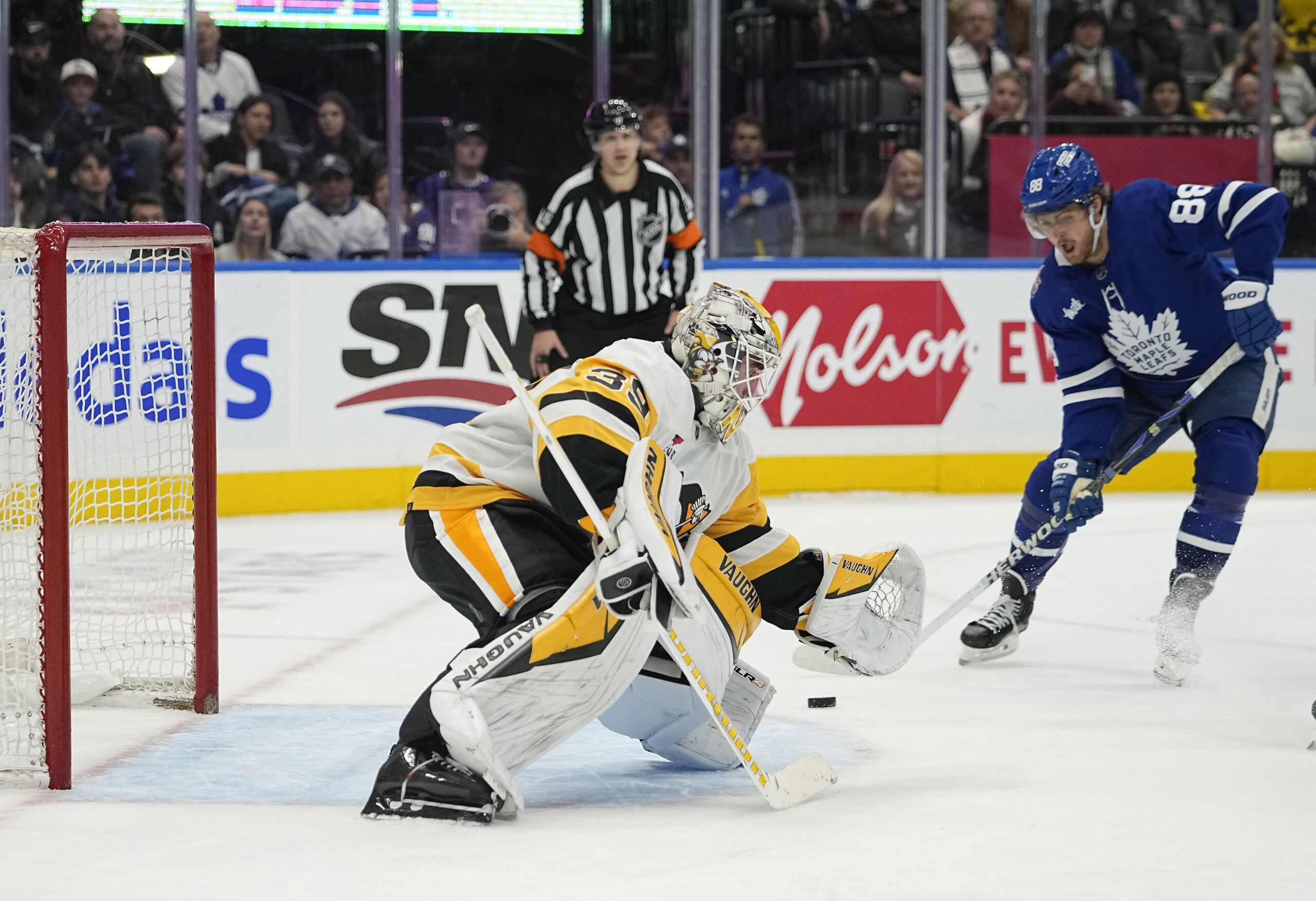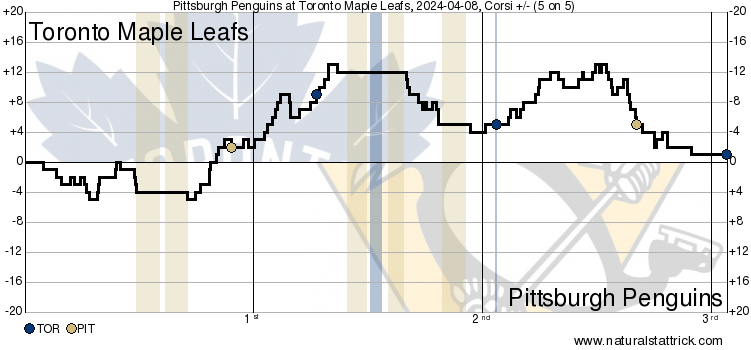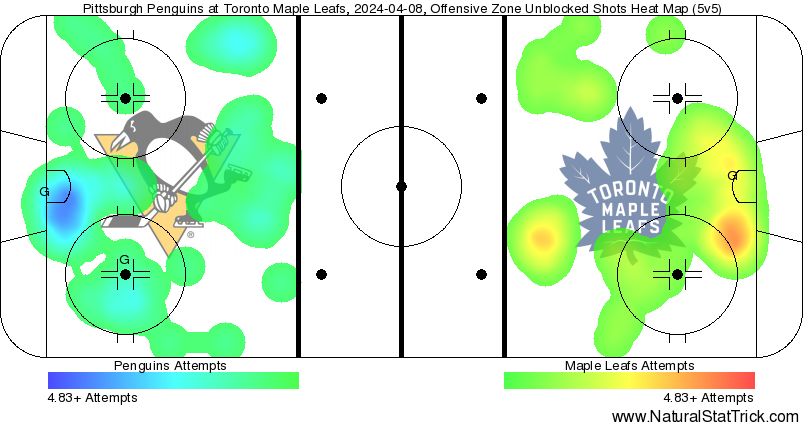The Maple Leafs took on a desperate Penguins team, and while they didn’t quite take care of business before overtime, they took a piece out of Pittsburgh’s playoff push with an extra-time win.
Ilya Samsonov was again excellent and is clearly the Leafs‘ starter heading into the playoffs. The three-line attack got another game together, but the story for much of the game was the penalty disparity as the Leafs spent nearly a quarter of the first two periods killing penalties. Toronto’s penalty kill held serve, and their power play — via Auston Matthews — scored before the Leafs dominated overtime until eventually scoring the game-winner via Jake McCabe.
Your game in 10:
1. The Leafs got off to a poor start to this game. At the beginning of the first shift, they started the Bobby McMann – John Tavares – Mitch Marner line against the Crosby line, which went fine enough. They put the puck deep, Marner finished a hit, and there wasn’t much happening in the game.
However, when the puck returned to their zone, Simon Benoit seemingly couldn’t handle it. He fanned on the puck, recovered it, and tried to settle the play down as the Penguins went for their first line change. Reilly Smith hopped on, and on a 1v2 forecheck against Benoit and Jake McCabe, Benoit fanned on it again, leading to a turnover this time.
The Penguins started generating some zone time, and the Leafs ended up icing the puc. Benoit-McCabe were on the ice for roughly two minutes to start the game. It set the tone for the first few minutes as the Penguins built on it and put together several good shifts, controlling play in the Leafs’ end even if they weren’t creating anything of note.
Eventually, the Leafs’ fourth line broke the pressure by finally getting it out and chipping it in deep. Ryan Reaves was first in on the forecheck before TJ Brodie kept it in along the wall as the Leafs created some zone time. The first line put together a good shift afterward, with Tyler Bertuzzi getting a rebound chance in front. It was the first of a few good chances for the trio in the period, which was easily the Leafs’ best line.
It was clear the Penguins were focused on forechecking the Leafs’ defense core aggressively, and the first few minutes made it evident they could create all sorts of turnovers against them.
2. As the game started to even out and the teams were trading good shifts, the Leafs ran into penalty trouble. First, Benoit took a tripping penalty against Michael Bunting.
The previous game in Montreal was the first with Mitch Marner back in the lineup, but we didn’t get to see what the penalty-kill rotation truly looked like as the Leafs only took one penalty and were scored against right away with the top unit on the ice. Today, we got a first look at their rotation, and while the first unit was still David Kampf – Connor Dewar (as expected) I thought it was interesting that PK unit #2 was Pontus Holmberg – William Nylander.
Marner came out afterward with Kampf on the third line change and definitely looked as if he was adjusting to the Leafs’ more aggressive penalty kill. He was a step slow when applying pressure, and you could see him thinking it through rather than playing it aggressively.
TJ Brodie–Jake McCabe was the first D pairing, and with Benoit in the box, the second pairing was Mark Giordano–Ilya Lyubushkin. The Leafs killed off the penalty but were helped by Ilya Samsonov robbing Sidney Crosby on a one-timer attempt. They also went on a 2v1 with Dewar and Kampf where Dewar clearly wanted to pass but was forced to shoot, which didn’t go very well.
After killing the penalty, Lyubushkin took a second penalty and the PK had the same rotation: Kampf – Dewar, Holmberg – Nylander, and Kampf – Marner. The defense was the same, except it was Benoit instead of Lyubushkin, and the Leafs once again killed it off.
3. After the penalty kills, the Leafs created a few good shifts and looked to be settling into the game. The Matthews line, in particular, was buzzing and created a good chance. It looked like we would get a scoreless first period, but with a few minutes left, the Leafs shot themselves in the foot.
It was an innocent enough start to the sequence as the Leafs were in the Penguin’s end before the puck was flipped out to the far blue line. Ilya Lyubushkin was the last man back, and this whole sequence started because he tried to shake the forechecker (Michael Bunting) by curling to his backhand side instead of his forehand side. Either he has to use the net or go to his forehand, but he’s not good enough with the puck to justify going to his backhand side in that situation.
When Lyubushkin turned up ice, there was pressure on the wall, and he made matters worse by trying to bump a pass to the middle (on his backhand), resulting in a turnover. Malkin picked up the puck and passed it to Rakell in the high slot. Rakell spun and fired a no-look shot to the net, knowing traffic was in place. It found the back of the net to make it 1-0 Pittsburgh.
4. In the same way that the start of the first period set the tone for the opening frame, so did the start of the second. The difference is that the Leafs came out buzzing this time and applied the pressure.
This time, the John Tavares line started again and instantly went to work. On the next shift, the Pontus Holmberg line created pressure, resulting in a Lyubushkin slap shot through traffic that just missed. The Auston Matthews line came out next and generated great pressure as the Leafs were coming at Pittsburgh in waves early to start the period. Much like the Leafs’ opening defense pairing in the first period, the Penguins’ defense pairing was on the ice for a two-minute shift to start the middle frame.
The early pressure paid off as the Leafs scored off an offensive-zone faceoff following an icing. The Matthews line applied the pressure and wore out the Penguins, leading to the icing. Holmberg won the draw before William Nylander pounced on the puck and settled things down. The Leafs worked puck across the umbrella, going from Nylander on the half-wall to Morgan Rielly up top to TJ Brodie on the other side, where he had time and space. Brodie made a nice play — similar to what he did against Florida last week — to freeze and find Matthew Knies at the backdoor for a tap-in.
That’s seven points in seven games for Knies and six in eight for Brodie. Again, it will be hard to justify taking out Brodie when he’s on PK1; the team is playing well; he’s routinely playing over 20 minutes per night, and now he’s producing to boot.
5. It felt like the Leafs turned the tide for the game and would be able to build on their goal, but a few minutes later, they took a penalty where William Nylander tried to poke the puck off Crosby, Crosby clamped onto his stick, and the refs took over the rest of the period.
I’m not sure how else to break it down. By the time the second period ended, the penalties in this game were 5-1 in favour of Pittsburgh. The Leafs’ one power play was an abbreviated one as it came off a shorthanded breakaway by Marner (on a nice flip pass by Kampf) where he was slashed.
The Leafs’ one shortened power play was weak as Nylander came out of the box, and — seemingly perturbed — he instantly tried to take a slapshot off the rush instead of setting it up. It cleared the zone wide before the Leafs botched an entry and regrouped. Morgan Rielly hit Mitch Marner with a stretch pass for a breakaway he couldn’t convert.
Bryan Rust promptly came back down on a 1v2 against Matthews and beat him wide for a scoring chance that resulted in a penalty call. It gave the Penguins their fourth power play of the night, but they generated nothing on it.
A few minutes later, it was Jake McCabe’s turn to take a penalty; this time, McCabe and Crosby were engaged off the puck, and Crosby sprawled into the net. There was no hand up on the original play, but as Crosby was slow to get up, the officials seemingly decided it was a penalty.
The Leafs killed it off again, and as the penalty expired, Bobby McMann swung at a puck in the air that hit Crosby in the face and cut him. The refs blew the play dead (which was incorrect) and called a double minor (which would have put the power play count at 7-1), only to review and overturn it as if it was the puck that hit Crosby, not McMann’s stick.
As the period mercifully neared an end, Matthews and Crosby collided in the Leafs’ end as the puck was heading up ice, where Domi and Bertuzzi were exiting the zone with speed and possession. The refs blew the play dead even though there was no injury. The icing on top of the cake: Despite the Leafs possessing the puck and Crosby going down, the officials still made it a defensive-zone faceoff for Toronto.
6. Back at 5v5 to start the third period, the Leafs went back to playing in the Penguins’ end. The Tavares line again started the frame and did well. The Matthews line came on next and hemmed the Penguins in their zone for an extended shift, leading to an offensive-zone faceoff.
Similar to the first goal where the Matthews line dominated and then the Holmberg line followed up, they came out again in the third, but this time, Nylander tried to drive the net, drawing a tripping penalty.
This power play didn’t last long at all. Tavares won the faceoff cleanly, and Matthews immediately stepped into a slapshot. It seemed to fool Alex Nedjelkovic, who was cheating a bit to his right because Marner was there. Matthews blasted it short side to his left for his 65th goal of the season, tying Ovechkin’s career-best season.
MATTHEWS 65th of the Season vs Penguins courtesy of Joe Bowen and Jim Ralph. #LeafsForever @Bonsie1951 @Jim_Ralph @LeafsJelly
4/8/2024 pic.twitter.com/lnatF20i6D
— Maple Leafs Hotstove (@LeafsNews) April 9, 2024
This also marked Tavares’ 60th point of the season, giving him 12 straight seasons of 60 or more. It wasn’t much of a traditional “power-play goal,” but it was a power-play goal in a big moment. They all count.
7. To this point in the game, William Nylander produced zero points but played a direct role in both goals. On the first one, as noted, it was Nylander who was ready to go on the offensive-zone faceoff; he won the race to the puck and settled everything down to start the entire sequence. On the second goal, as noted, Nylander drew the penalty.
Pontus Holmberg is playing admirably at center, but he is clearly a work in progress down the middle. Nylander often plays down low like a center in the defensive zone, getting the puck back and leading breakouts on his own. He’s pushing 100 points this year, and this late in the season, he’s playing with two players who have combined for 50 points total. He’s doing it without complaining and is still impacting the game positively.
I can’t say enough good things about how Nylander is handling himself. Many other players would not take those linemates so late in a career season as gracefully. To me, this is what true superstars do: play with anyone and make them better.
8. As expected, a desperate Penguins team began to dial up the pressure, but the Leafs were still generating zone time and were in relatively good shape.
The first sign of trouble came from the John Tavares line. After a good start to the shift, when they put it in deep and created some zone time, the puck came out to center, where Mitch Marner elected not to get it deep and get off. Instead, he passed it to Bobby McMann, who also elected not to get it deep and get off the ice in the second half of their shift. McMann attempted a soft chip off the wall at the Penguins’ blue line for a turnover.
The Penguins went down the ice and Tavares retrieved it back, but instead of flipping it out and getting off at the end of his shift, Tavares attempted a pass up the middle that went for a turnover and eventually an icing.
It wasn’t a surprise when the Tavares line conceded a goal on their next shift. The goal itself was simply a lost battle. Marner hung back when the puck was in the neutral zone, and when the puck was dumped into the Toronto end, he was first to the puck but didn’t attempt to make a play on the puck at all. He tried to eat it, and Jake McCabe and Simon Benoit seemed a little confused, tepidly engaging in the battle in the corner. The Leafs didn’t win the battle before the puck went to the far-side point.
The Leafs didn’t box out all of the Penguins in the corner heading to the net. The point shot was sent low and to the net, where O’Connor stood in the crease to bang the loose puck home.
9. Not much was created either way for the rest of the period. Both teams were diligent defensively, and in the final minute, they were clearly playing for the extra point.
The Penguins prioritized dumping the puck in and getting in on the forecheck, whereas the Leafs tried to skate through the neutral zone and were stonewalled multiple times. When games are tight like this, the Leafs have to simplify, and it’s no surprise to see a team full of veterans, such as the Penguins, do exactly that compared to a team littered with young players making those mistakes.
On one play with a few minutes left in the third, Nylander won a battle at center and kicked the puck to Knies in the middle of the ice. Instead of dumping it in and forechecking, Knies tried to stickhandle while surrounded by three Penguins. These are often the things that burn a team in the playoffs.
The Leafs gave away a free goal in the first period and made life difficult on themselves more than the Penguins doing anything special. When they did advance the puck, they could create and hem Pittsburgh in with some level of regularity (in between all the penalties in the game).
10. In overtime, interestingly, Sheldon Keefe started Auston Matthews with Max Domi instead of Mitch Marner. He’s fully leaning into it at this point.
Morgan Rielly lost the puck off the draw, and the Penguins fired a puck wide. The next two Leafs on the ice were Marner and William Nylander alongside TJ Brodie. Nylander had a path to the net and looked like he might end the game all alone, but he missed when he tried to pull the puck to the far post. That was okay, though, as the Leafs maintained pressure and possession.
Matthews returned to the ice and won a battle against a tired Penguins unit, flipping the puck out to a changing Marner, who read that Tyler Bertuzzi was back on the bench before touching the puck back to Matthews. #34 ripped it across the ice to Jake McCabe, who scored his first-ever overtime goal for his career-high 26th point of the season and counting — not to mention a career-high eight goals and counting.
MCCABE OT WINNER vs Penguins courtesy of Joe Bowen and Jim Ralph. #LeafsForever @Bonsie1951 @Jim_Ralph @LeafsJelly
4/8/2024 pic.twitter.com/N6ShTXHbhX
— Maple Leafs Hotstove (@LeafsNews) April 9, 2024
McCabe has been a rock this season, and his offensive contribution has been a pleasant surprise. For a defense that doesn’t create much, McCabe’s emerging as a credible offensive threat was sorely needed.
































![New Leaf Anthony Stolarz on the opportunity in Toronto: “In Florida, I knew my role as a backup… Now, [Joseph Woll] and I are competing for starts… As a goalie, that’s all you can ask for” Anthony Stolarz, Stanley Cup win, now Maple Leaf](https://mapleleafshotstove.com/wp-content/uploads/2024/07/anthony-stolarz-sc-100x70.jpg)
